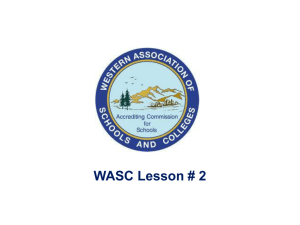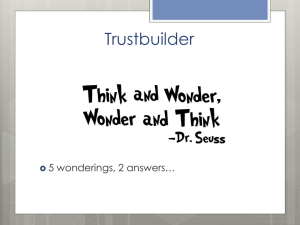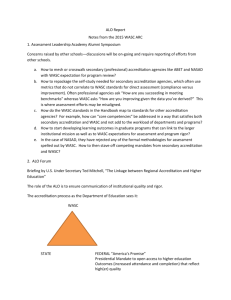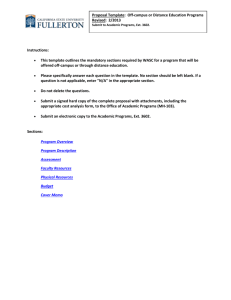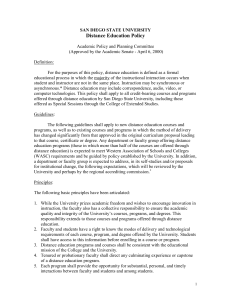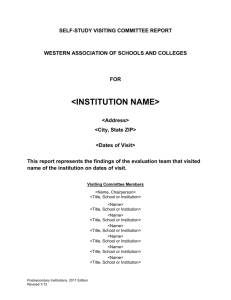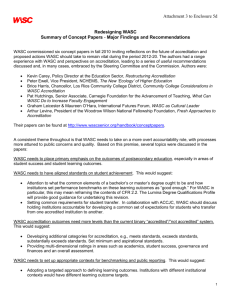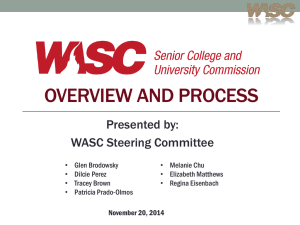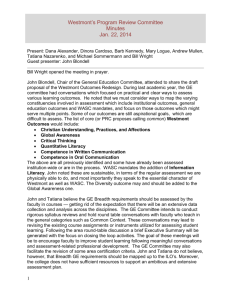ACS WASC Postsecondary COE Supplement Report Template
advertisement
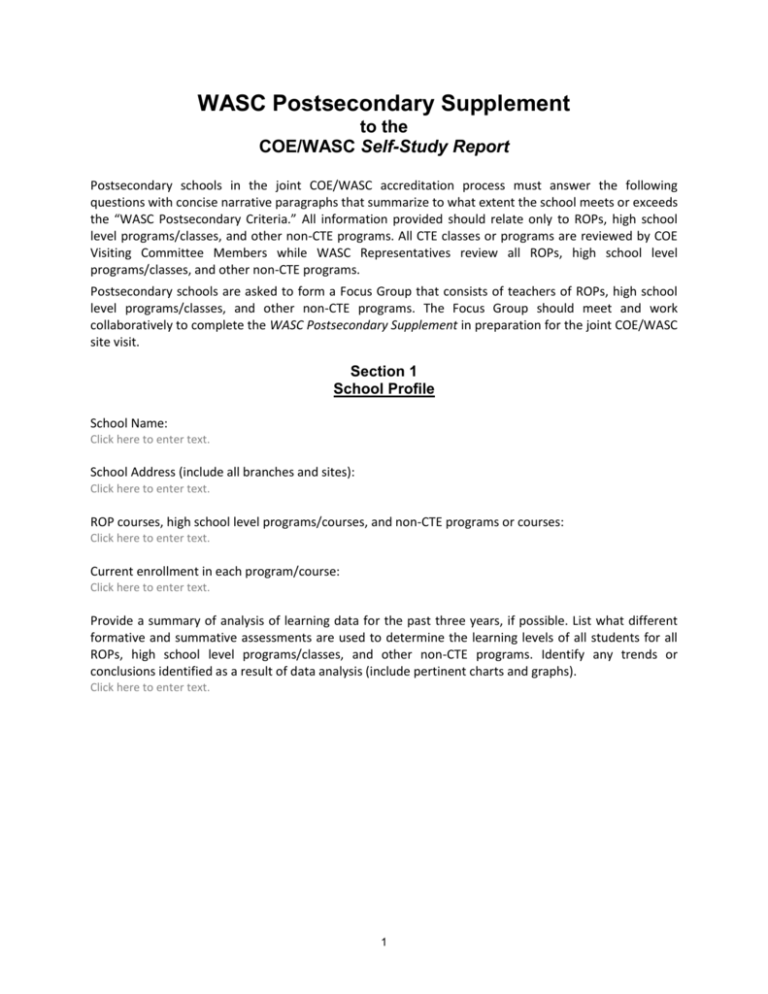
WASC Postsecondary Supplement to the COE/WASC Self-Study Report Postsecondary schools in the joint COE/WASC accreditation process must answer the following questions with concise narrative paragraphs that summarize to what extent the school meets or exceeds the “WASC Postsecondary Criteria.” All information provided should relate only to ROPs, high school level programs/classes, and other non-CTE programs. All CTE classes or programs are reviewed by COE Visiting Committee Members while WASC Representatives review all ROPs, high school level programs/classes, and other non-CTE programs. Postsecondary schools are asked to form a Focus Group that consists of teachers of ROPs, high school level programs/classes, and other non-CTE programs. The Focus Group should meet and work collaboratively to complete the WASC Postsecondary Supplement in preparation for the joint COE/WASC site visit. Section 1 School Profile School Name: Click here to enter text. School Address (include all branches and sites): Click here to enter text. ROP courses, high school level programs/courses, and non-CTE programs or courses: Click here to enter text. Current enrollment in each program/course: Click here to enter text. Provide a summary of analysis of learning data for the past three years, if possible. List what different formative and summative assessments are used to determine the learning levels of all students for all ROPs, high school level programs/classes, and other non-CTE programs. Identify any trends or conclusions identified as a result of data analysis (include pertinent charts and graphs). Click here to enter text. 1 Section 2 Response to WASC’s Postsecondary Criteria Please respond to the following WASC Postsecondary Criteria by providing two or more paragraphs to each question as appropriate: Criterion 1 – Institutional Mission and Schoolwide Learner Outcomes 1. Provide the school’s mission statement. Click here to enter text. 2. Identify the Schoolwide Learner Outcomes (SLOs). Click here to enter text. 3. Explain the degree to which SLOs are used to impact curriculum development, professional growth activities, resource allocations, or other school improvement activities? Click here to enter text. 4. Evaluate the purpose of your non-CTE programs, your ROP programs, or any other high school level programs/courses that you offer. Why are you offering these programs? Click here to enter text. 5. Describe the demographic make-up of your student body. Click here to enter text. Criterion 2 – Organizational Infrastructure and School Leadership 1. Describe the school leadership structure and the lines of authority established by the governing body. Click here to enter text. 2. Describe to what extent the governing body interacts with the school leadership throughout the school year. Click here to enter text. 3. To what extent has the school developed written policies and procedures that govern the operations of the school? Click here to enter text. Criterion 3 – Faculty and Staff 1. List the teaching faculty and provide information regarding their degrees and experience to verify their qualifications (a chart format is preferred). Click here to enter text. 2. How effective is the annual evaluation of the teachers? Click here to enter text. 2 3. To what extent does the school provide professional development opportunities for the teaching staff? Click here to enter text. Criterion 4 – Curriculum 1. To what extent does the school have a written curricular map that describes courses and outlines student learning outcomes for each course/program? Click here to enter text. 2. To what degree and how often does the school review and revise the curriculum? Click here to enter text. 3. To what extent are curricular resources available to all students so that they can successfully complete course requirements? Click here to enter text. Criterion 5 – Instructional Program 1. To what extent does the school provide a rigorous educational experience for all students? Click here to enter text. 2. To what degree are a variety of instructional methods/strategies used to provide successful learning opportunities for students? Click here to enter text. 3. To what extent does the school integrate technology into the instructional program? Click here to enter text. Criterion 6 – Use of Assessment 1. List what formative and summative assessments are used to measure student learning progress. Click here to enter text. 2. To what extent does the administration and faculty gather learning data from multiple sources, disaggregate the data, and analyze the results to draw clear conclusions? Click here to enter text. 3. To what extent does the administration and faculty take the conclusions drawn from the analysis of learning data and create recommendations to address areas of needed improvement? Click here to enter text. 3 4. To what extent is the analysis of learning data used to improve the instructional program of the school? Click here to enter text. Criterion 7 – Student Support Services 1. Describe and evaluate what support services are provided to students, including academic counseling, personal counseling, and health services. Please describe what is included in each service provided. Click here to enter text. 2. To what extent does the faculty/staff guide students through the admissions process all the way to the completion of courses and/or programs? Click here to enter text. 3. Evaluate the means by which the school maintains student records in a permanent, secure, and fireproof location. Click here to enter text. 4. To what extent does the school communicate with students and make information available as requested? Click here to enter text. Criterion 8 – Resource Management 1. To what extent does the school have sufficient resources to offer its current educational courses/programs? (Please provide a copy of the school’s budget.) Click here to enter text. 2. Comment on the effectiveness of how the school maintains integrity in financial practices, audits, and financial reporting to all stakeholders. Click here to enter text. 3. Provide evidence that the school provides clean, safe, and well-maintained facilities that are sufficient for the courses/programs offered? Click here to enter text. Criterion 9 – Community Connection 1. To what extent does the school connect to community leaders, local businesses, and vocational partners in order to enhance the school’s academic program? Click here to enter text. 4 2. How effective has the school been in providing student service projects that impact the community in a positive manner? Click here to enter text. Criterion 10 – Action Plan for Continuing Improvement 1. Describe and evaluate how the school’s Action Plan is created, maintained, and used to guide the school in ongoing improvement efforts. Click here to enter text. 2. To what extent have the ROPs, high school level programs/classes, and other non-CTE programs identified critical areas of needed improvement that are part of the school’s Action Plan? Click here to enter text. 5 Section 3 Schoolwide Strengths and Critical Areas for Follow-up After reviewing the results of the answers provided in the preceding pages, please identify what you believe your school does very well, i.e., areas of strength in regard to the ROPs, high school level programs/classes, and other non-CTE programs that are offered. Schoolwide Strengths 1. Click here to enter text. 2. Click here to enter text. 3. Click here to enter text. 4. etc. Next, please identify at least 3–5 schoolwide critical areas of needed improvement. Prioritize this list in order of importance to the school. Schoolwide Critical Areas for Follow-up 1. Click here to enter text. 2. Click here to enter text. 3. Click here to enter text. 4. etc. In addition, please attach a copy of the current Action Plan. This WASC Postsecondary Supplement will be used by the WASC Representative(s) during the COE/WASC site visit to evaluate the ROPs, high school level programs/classes, and other non-CTE programs that are offered. The WASC Representative(s) of the Visiting Committee will write a separate report to the WASC Commission at the conclusion of the joint COE/WASC visit. Please send an electronic copy and hardcopy of the completed WASC Postsecondary Supplement at least four weeks before the site visit to: Western Association of Schools and Colleges 43517 Ridge Park Dr., Suite 100 Temecula, CA 92590 6
